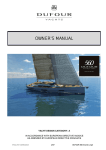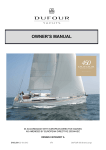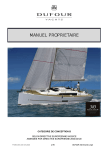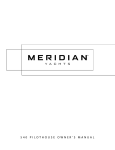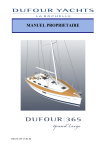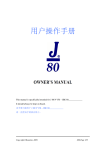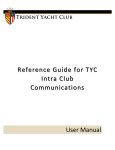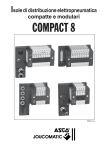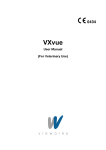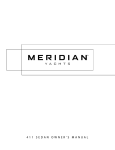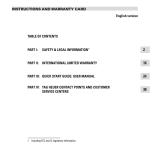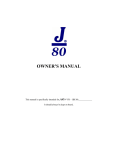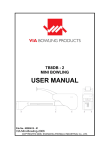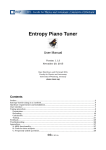Download owner`s manual - Dufour Yachts Magyarország
Transcript
OWNER’S MANUAL
DESIGN CATEGORY A
IN ACCORDANCE WITH EUROPEAN DIRECTIVE 94/25/EC
AS AMENDED BY EUROPEAN DIRECTIVE 2003/44/EC
ENGLISH 18-04-2013
1/72
DUFOUR 410 Grand Large
Cette page est blanche intentionnellement
This page is intentionally left blank
Cette page est blanche intentionnellement
This page is intentionally left blank
Cette page est blanche intentionnellement
This page is intentionally left blank
ENGLISH 18-04-2013
2/72
DUFOUR 410 Grand Large
Your agent:
Name
is DUFOUR YACHTS' representative and will give you all the help you need to resolve any
difficulties you might have during launching and masting of your boat, as well as for commissioning
and maintenance technical checks. If necessary, he will help you with the administrative process of
registering your boat.
As soon as you become the owner, familiarize yourself with the manual supplied with your boat,
sign and date the receipt acknowledgements below, and give (or send) the last one to your agent.
Owner's Manual receipt acknowledgement to be kept in your Manual
I, the undersigned:
Name
Address
owner of DUFOUR 410 No.
confirm that I have received the Owner’s Manual for my DUFOUR 410 and accept
its being written in English.
Dated:
Signature:
Detach along dotted line
…………………………………………………………………………………………………………………
Owner’s Manual receipt acknowledgement to be returned to DUFOUR
YACHTS
11, Rue Blaise Pascal- 17187 PERIGNY CEDEX- FRANCE
I, the undersigned:
Name
Address
owner of DUFOUR 410 No.
confirm that I have received the Owner’s Manual for my DUFOUR 410 and accept
its being written in English.
Dated:
Signature:
ENGLISH 18-04-2013
3/72
DUFOUR 410 Grand Large
Cette page est blanche intentionnellement
This page is intentionally left blank
Cette page est blanche intentionnellement
This page is intentionally left blank
Cette page est blanche intentionnellement
This page is intentionally left blank
ENGLISH 18-04-2013
4/72
DUFOUR 410 Grand Large
CONTENTS
INTRODUCTION ........................................................................................................................................... 7
I.
GENERAL INFORMATION ................................................................................................................. 8
Design category __________________________________________________________________________ 8
Certification______________________________________________________________________________ 8
Identification _____________________________________________________________________________ 8
Builder's plate____________________________________________________________________________ 9
Degrees of danger ________________________________________________________________________ 9
II.
PRINCIPAL SPECIFICATIONS ........................................................................................................10
III. ELECTRICAL SYSTEMS ......................................................................................................................12
Safety and operating instructions for the electrical system _________________________________ 12
Installing new equipment ________________________________________________________________ 12
Batteries ________________________________________________________________________________ 13
Electric windlass ________________________________________________________________________ 13
220 V / 110 V installation (ISO 13297:2000) _________________________________________________ 14
IV. GAS INSTALLATION ............................................................................................................................15
Operating advice ________________________________________________________________________ 15
Circuit check (ISO 10239:2000) ___________________________________________________________ 16
Changing the gas cylinder _______________________________________________________________ 16
V. DRAIN & SANITATION SYSTEM ..........................................................................................................17
Specifications of the drain system (ISO 15083:2003) _______________________________________ 17
Pressurized fresh-water pump ____________________________________________________________ 17
Seacocks _______________________________________________________________________________ 18
Operation of the sea toilets_______________________________________________________________ 18
Holding tank operation (ISO 8099:2000) ___________________________________________________ 18
VI. FLOODING ............................................................................................................................................19
VII. FIRE PROTECTION .............................................................................................................................19
Installation ______________________________________________________________________________ 19
Safety instructions ______________________________________________________________________ 20
VIII. ENGINE ...............................................................................................................................................21
General precautions _____________________________________________________________________ 21
Exhaust gas emissions __________________________________________________________________ 21
Safety21
Wintering _______________________________________________________________________________ 22
IX. FUEL INSTALLATION ..........................................................................................................................22
X. STEERING SYSTEM ..............................................................................................................................22
Helm ___________________________________________________________________________________ 22
Emergency tiller _________________________________________________________________________ 23
XI. SAILING .................................................................................................................................................23
XII. PREVENTION OF FALLS AND MEANS OF REBOARDING .............................................................24
XIII. LIGHTNING PROTECTION.................................................................................................................24
Maintenance ____________________________________________________________________________ 24
Protection of persons during a storm _____________________________________________________ 24
XIV. ENVIRONMENTAL PROTECTION & SAFETY ..................................................................................25
XV. SAFETY FACILITIES ...........................................................................................................................26
XVI. HANDLING, TRANSPORTING, HAULOUT .......................................................................................26
XVII. DOCKING, MOORING AND TOWING ..............................................................................................27
Responsibility___________________________________________________________________________ 27
Non-metallic anchor points_______________________________________________________________ 27
XVIII. GUARANTEE, TRANSFER OF OWNERSHIP .................................................................................28
1.
Presentation plan ........................................................................................Erreur ! Signet non défini.
2.
Accommodation layout ..............................................................................Erreur ! Signet non défini.
ENGLISH 18-04-2013
5/72
DUFOUR 410 Grand Large
3.
Deck fittings plan ....................................................................................... Erreur ! Signet non défini.
4.
Sail diagram................................................................................................ Erreur ! Signet non défini.
5.
Halyard and sheet operating diagram ..................................................... Erreur ! Signet non défini.
6.
220 V circuit diagram ................................................................................. Erreur ! Signet non défini.
7.
Charging & power circuit diagram ........................................................... Erreur ! Signet non défini.
8.
12 V distribution panel diagram ............................................................... Erreur ! Signet non défini.
9.
Electrical wiring panel diagram ................................................................ Erreur ! Signet non défini.
10.
12 V electrical installation diagram .......................................................... Erreur ! Signet non défini.
11.
220 V electrical installation diagram ........................................................ Erreur ! Signet non défini.
12- Fuse installation diagram ............................................................................. Erreur ! Signet non défini.
13.
Steering system diagram .......................................................................... Erreur ! Signet non défini.
14.
Gas system diagram .................................................................................. Erreur ! Signet non défini.
15.
Abandon ship plan..................................................................................... Erreur ! Signet non défini.
16.
Fresh-water system diagram .................................................................... Erreur ! Signet non défini.
17.
Drain system diagram ............................................................................... Erreur ! Signet non défini.
18.
Skin fitting location diagram .................................................................... Erreur ! Signet non défini.
19.
Engine installation diagram ...................................................................... Erreur ! Signet non défini.
20.
Holding tank installation diagram ............................................................ Erreur ! Signet non défini.
21.
Lifting diagram ........................................................................................... Erreur ! Signet non défini.
ENGLISH 18-04-2013
6/72
DUFOUR 410 Grand Large
INTRODUCTION
DUFOUR YACHTS is pleased to present you with this Manual which will help you get to know your boat
better.
This Manual has been produced to help you use your boat safely and enjoyably. It contains details of the
boat, the equipment supplied or fitted, its systems and information about their use. Read it carefully and
familiarize yourself with the boat before using it.
This Owner’s Manual is not a course in sailing safety or seamanship. If this is your first boat, or you are
changing to a type of boat you are unfamiliar with, for your convenience and safety, make sure you gain
experience handling and using it before taking command. Your agent, your national sailing or cruising
federation or your yacht club will be happy to give you information about sailing schools or qualified
instructors in your area.
Ensure that forecast wind and sea conditions correspond to the design category of your boat, and that you
and your crew are capable of handling the boat in these conditions. Even when your boat is suitable for
them, the sea and wind conditions corresponding to design categories A, B, and C vary from severe storm
for category A to severe conditions for the top end of category C, subject to dangers of abnormal gusts or
waves; these are dangerous conditions in which only an experienced, trained crew in good condition,
sailing a properly-maintained boat, can sail in a satisfactory manner.
This Owner's Manual is not a detailed maintenance or repair guide. In the event of problems, consult the
boatbuilder or the boatbuilder's representative. If a maintenance manual is provided, be sure to use it.
Always employ the services of an experienced professional for maintenance, fitting accessories, or
modifications. Modifications that could affect the characteristics of the boat must be assessed, carried out
and documented by qualified personnel. The boatbuilder cannot be held responsible for modifications
made without their approval.
In certain countries, a skipper’s licence or authorization is required, or special regulations are in force.
Always maintain your boat correctly and make allowance for deterioration due to age or resulting, where
applicable, from heavy or unsuitable use. Any boat, however sturdy it is, can be severely damaged if it is
used incorrectly. This is incompatible with safe sailing. Always suit your speed and heading to the
prevailing sea conditions.
If your boat is equipped with a life-raft, read its instruction manual carefully. The crew must have on board
all the safety equipment (life-jackets, harnesses, etc.) corresponding to the type of boat, weather
conditions, etc. In some countries, this equipment is mandatory. The crew must be familiarized with the use
of all the safety equipment and with emergency safety procedures (man overboard recovery, towing, etc.);
training sessions are regularly organized by sailing schools and clubs.
It is recommended that all persons wear appropriate buoyancy aids (life-jackets, personal flotation devices)
when on deck. It should be noted that in certain countries, it is compulsory to wear a buoyancy aid
(complying with national regulations) at all times.
KEEP THIS MANUAL IN A SAFE PLACE AND PASS IT ON TO THE NEW OWNER IF YOU
SELL THE BOAT.
WARNING: Our boats are regularly improved in the light of our customers’ experiences and
researched by the shipyard, and so the specifications given in this Owner’s Manual are not
contractually binding and may be changed without notice and without any obligation to
update. This manual is intended to cover as much information as possible, so certain
equipment or paragraphs might not apply to your boat. In case of doubt, please refer to the
inventory which should have been given to you by your agent when you placed your order.
ENGLISH 18-04-2013
7/72
DUFOUR 410 Grand Large
G E N E R A L I N F O R M AT I O N
Design category
Your DUFOUR 410 comes under the OCEAN-GOING design category A.
Under conditions of normal use, your boat is designed to sail in waves with a significant height
exceeding 4 m and winds of force 8 or above on the Beaufort scale, and to withstand the severest
conditions.
This sailing capability is equally dependent on the skills of the crew, their physical capacities, the
maintenance of the boat and its equipment.
So always take care before putting to sea.
DUFOUR YACHTS is not able to guarantee perfect functioning of the boat in exceptional sea
conditions (violent storms, hurricanes, cyclones, waterspouts, etc.)
SUMMARY OF DESIGN CATEGORIES
Type of sailing
Wind strength
(Beaufort)
Wind speed
Significant wave
height to be taken
into account
A
Ocean-going
Greater than 8
Up to 28 m/s
Higher than 4 m
B
Open sea
C
Inshore
D
Sheltered waters
Design
categories
Up to and
including 8
Up to and
including 6
Up to and
including 4
Up to 21m/s
Up to 17 m/s
Up to 13 m/s
Up to and including
4m
Up to and including
2m
Up to and including
0.5 m
Check weather information before putting to sea: Take to the sea, don’t take risks !
In port: every day, the Harbor Master's Office posts weather bulletins and forecasts for the
next few
days.
Météo France on 0836 68 08 08
Navifax - direct on 0836 70 18 52
VHF: CROSS transmit several bulletins per day, preceded by an announcement on Channel
16.
Certification
DUFOUR YACHTS has chosen the Institut pour la Certification et la Normalisation dans le
Nautisme as the notified body for verifying that your boat complies with European directive CE
94/25, as per module B.
Identification
The hull identification number is located on starboard side of transom. It contains a series of letters
and numbers that begin with FR-DUF...
ENGLISH 18-04-2013
8/72
DUFOUR 410 Grand Large
Builder's plate
Part of this information is given on the builder’s plate
attached to the boat. A full explanation of this
information is given below.
Design category = A
Max. number of people aboard:
category A = 8
category B = 10
category C = 12
category D = 12
: Ocean-going (see 1.1)
: Recommended by the builder for navigation in sea
conditions for category for which it was built.
WARNING
Do not exceed the maximum recommended number of people. However many people there are
aboard, the total weight of the people and equipment must never exceed the maximum
recommended loading.
Max. recommended load:
category A = 1730 kg
category B = 1790 kg
category C = 1790 kg
category D = 1730 kg
: : recommended by the builder, including the weight
of all persons aboard, the provisions and personal
effects, and of all equipment not included in the light
displacement weight of the boat, excluding the
content of the tanks.
WARNING
When loading the boat, never exceed the recommended maximum load. Always load the boat
carefully and distribute the weight in a suitable manner in order to maintain the theoretical trim
(approximately horizontal). Avoid placing heavy loads high up.
CE 0607
Degrees of danger
DANGER
WARNING
CAUTION
: CE mark indicating that the boat complies with all the
requirements of the Directive. : The sequence of numbers
is the Certification institution's code, in this case the ICNN
(Institut pour la Certification de la Normalisation dans le
Nautisme), (see also: Safety Compliance Declaration).
Indicates the existence of an extreme intrinsic risk that may give rise
to a high probability of death or serious injury if appropriate
precautions are not taken.
Indicates the existence of a risk of injury or death if appropriate
precautions are not taken.
Indicates a reminder of safety practices or attracts attention to
hazardous practices that may cause injuries, or damage to the boat,
its components or the environment.
ENGLISH 18-04-2013
9/72
DUFOUR 410 Grand Large
I . P R I N C I PA L S P E C I F I C AT I O N S
Model:
Builder
Lmax
LH
Bmax
BH
HA
Tmax
MLC
MMO
ML
MLDC
Designer:
Interior design
Design category
Notified body No.
Engine #
Primary means of propulsion
LOA*
Hull length*
Maximum beam*
Hull beam*
Max. air draft*
Draft (deep ballast)*
Deep ballast weight
Draft (shallow ballast)
Shallow ballast weight
Standard mainsail area (approximate)
Genoa area (approximate)
Maximum permissible on-board engine power
Water capacity excluding 20 L water-heater
(approximate)
Diesel capacity (approximate)
Holding tank
Engine battery
Auxiliary battery (1 as standard + 1 as option)
+ 1 with electric winch option
Light displacement
Minimum displacement condition
Maximum load
Total weight of liquids (all tanks full)
Maximum load displacement
DUFOUR 410
Grand Large
Dufour Yachts
11, Rue Blaise Pascal
17187 Périgny cedex
FRANCE
Umberto Felci
DUFOUR Design
A
CE/0607
Voile
12.33 m
11.98 m
4.20 m
4.20 m
17.85 m
2.10 m
2600 kg
1.75 m
2700 kg
41 m²
37.5 m²
55 hp / 41 kW
360 L
200 L
50 L (+45L option)
100 Ah
100 Ah (+100 Ah option)
100 Ah
8940 kg
9220 kg
2250 kg
526 kg
11190 kg
* The above dimensions are in compliance with ISO 8866, i.e.:
Lmax: maximum length of the boat including parts that are normally fixed, such as rollers, pulpits,
etc.
LH : maximum length of the boat including the structural and integral parts of the boat, and
excluding the removable parts.
Bmax: beam of boat measured between the outermost parts and possibly including removable
parts such as rubbing strakes, guard rails, etc.
BH: beam of boat measured between the outermost fixed parts and excluding all removable
parts
HA: vertical distance between the waterline in light displacement condition and the highest point
of the mast structure. (this measurement does not take into account the equipment such as
lights and antennas that may be fixed to the top of the mast)
Tmax: the max. draft is measured at the lowest point of the ballast equipping the boat
ENGLISH 18-04-2013
10/72
DUFOUR 410 Grand Large
ML: the Maximum Load is the sum of the recommended maximum load (see builder's plate) and the
total mass of liquids (consumable or non-consumable)
NB: due to the trim and loading of the boat, it is not usually possible to use the whole of the
various tank capacities for fresh water and diesel. You are recommended to maintain a
diesel reserve of 20%.
Specific information
This boat has been evaluated with the aid of the stability index (STIX), a global safety
measurement with regard to stability, which considers the effects of the boat's length, its
displacement, the hull proportions, the stability characteristics and resistance to flooding.
The maximum total load is the sum of the recommended maximum load and the total mass of
liquids (see ISO 12217-2:2002).
The second index (AVS) represents the angle of disappearance of stability in degrees.
Minimum sailing
condition (MMO)
43.5
123.7°
STIX
AVS
ENGLISH 18-04-2013
11/72
DUFOUR 410 Grand Large
I I I . E L E C T R I C AL S Y S T E M S
Safety and operating instructions for the electrical system
WARNING
Improper use of the DC and/or AC systems may give rise to fire or explosion hazards.
Improper use of the AC systems may give rise to the risk of electrocution.
Always:
● Check the condition of the batteries (charge and electrolyte level) and the charging system
before putting to sea.
● Disconnect and remove batteries for wintering.
● Do not let battery voltage drop below 10·5 V during wintering.
● Carry spare bulbs for all navigation lights and interior lighting. Respect power ratings,
particularly for navigation lights.
● Check operation of the navigational instruments.
● Check operation of navigation lights before night sailings
Never:
● Work on an electrical installation that is live.
● Make any modification to an installation and the associated circuits, unless it is carried out
by an electrician qualified in marine electrics.
● Change or modify the breaking capacity of overload protection devices
● Replace electrical apparatus or equipment with units exceeding the rated capacity without
uprating the wiring and protection.
● Leave the boat unattended when the electrical installation is powered, with the exception
when applicable of the automatic bilge pump and the fire or theft protection circuits.
If a fuse or circuit-breaker blows continually, you should consult a specialist to determine the
cause of the short-circuit.
Installing new equipment
Since 1 January 1996, electrical equipment is subject to the European “electromagnetic
compatibility” directive (Ref 89/336/CEE). So new equipment being installed must meet this
standard and bear the CE mark. Equipment must also be supplied with a compliance
certificate and instructions for use.
In the case of 220 or 110 V installations, use only double-insulated or earthed equipment.
When such equipment is being installed, respect the fitting instructions (conductor size,
protection).
To avoid maintenance problems, be sure to enter in the manual any modifications that may
have been made to the electrical circuits.
ENGLISH 18-04-2013
12/72
DUFOUR 410 Grand Large
Batteries
The battery facilities consist of one 100 Ah auxiliary battery as standard (plus 1 x 100 Ah
optional battery) and one 100 Ah battery for engine starting.
Their capacities have been designed to handle the power requirements of the on-board
accessories. To avoid any problems, it is necessary to keep a close eye on the maintenance
and correct charging of the batteries.
ATTENTION!
● When installing new electrical appliances, take care that the overall consumption of these
appliances remains within the capacity of your batteries.
● Always disconnect the negative (-) battery terminal before the positive (+) terminal.
● Never allow a conductive object (tools, etc.) to bridge across the two battery terminals.
● When handling batteries, keep them horizontal to avoid spillage of electrolyte. Wear
gloves and protective clothing that will prevent any risk of contact with electrolyte in the
event of a leak.
In the event of electrolyte splashes, rinse the affected part of the body copiously and consult
a doctor.
Electric windlass
ATTENTION!
It is essential to run the engine with the throttle slightly open when using the electric
windlass.
ENGLISH 18-04-2013
13/72
DUFOUR 410 Grand Large
220 V / 110 V installation (ISO 13297:2000)
DANGER!
The on-board 220V installation is protected by a circuit breaker and fitted with a residual
current device. The wiring of additional 220 V on-board accessories must be carried out by
professionals, and the master circuit-breaker uprated if necessary.
-
Disconnect the boat’s power supply when system is not in use.
-
Connect the metal cases or housings of installed electrical equipment to the boat’s
protective conductor (green or green / yellow wire).
-
Use double-insulated or earthed electrical appliances.
ATTENTION!
When the boat is moored at the quayside, set the isolator to the "off" position.
DANGER!
Your boat is delivered without a boat / shore power supply cable or shore connection plug.
The cable used must be designed for exterior use. Its cross-sectional area must be
appropriate for its length and the rating of the main circuit-breaker (see electrical diagram).
The plug must be suitable for the socket on the shore (if necessary, seek the advice of a
professional). It should be as close as possible to the IP 67 / IEC529 type
● Switch off the shore supply at the on-board isolator before connecting or disconnecting
the shore/boat supply cable.
● Connect the shore/boat supply cable at the boat end before connecting it to the shore
outlet.
● Disconnect the shore/boat supply cable at the shore outlet before disconnecting it at the
boat end.
● Close the shore outlet cover properly
Never:
● Make modifications to the shore supply cable; you must only use compatible connectors.
● Go swimming close to a boat connected to a shore supply socket: danger of
electrocution!
Location of the 220 V master circuit-breaker: Aft technical area (access via port aft cabin).
Have the system inspected at least every two years.
During haul-out maintenance, set to the ‘on’ position in order to have earth [grounding]
protection via the shore socket.
WARNING
Never let the end of a ship/shore supply cable dangle into the water. It may create an
electrical field that could injure or kill nearby swimmers.
ENGLISH 18-04-2013
14/72
DUFOUR 410 Grand Large
I V. G A S I N S TA L L AT I O N
Operating advice
-
Read carefully all instructions for the cooker and regulator before use or maintenance.
-
Ensure that the gas cylinder and regulator are in accordance with the requirements of the
cooker (flow rate, pressure, type of gas) and with the regulations in force in the country
where it is being used.
-
Make sure the appliance gas taps are closed before opening the valve on the cylinder.
WARNING
● Fuel-burning naked-flame appliances use up the oxygen in the cabin and release
combustion products inside the vessel. Proper ventilation is necessary: open the nearest
deck hatch or porthole along with the companionway hatch when appliances are in use.
● Never block the ventilation openings and check that appliances with flues are working
properly.
● Do not use the cooker/oven as a means of heating.
-
Do not obstruct quick access to the elements of the gas installation (cylinder locker, shutoff valve).
-
The gas cylinder must always be stowed in the sealed, ventilated space provided. The
same applies to spare or empty cylinders. Keep close to hand the protective mechanisms,
lids or caps. No other equipment must be stowed in this space.
-
Never leave the boat unattended when gas appliances are on.
-
Close all valves in the circuit when the boat is left empty (shut-off valve, regulator valve),
even if the cylinder is believed to be empty. In the case of the latter, disconnect the
valves.
-
After the boat has been shut up, never smoke when going below, and ensure that there is
no smell of gas.
-
If you smell gas, close the circuit valves and the cooker taps, ventilate the boat, and find
the leak before using the installation again.
WARNING
In the event of an emergency, the circuit valves must be closed immediately (in particular, in
the event of fire).
ATTENTION!
Certain precautions must be taken to avoid any contact with naked flames or other hot areas.
Never use the cooker when there is a probability of high roll angles or permanent heel
angles (if the cooker is not suspended from gimbals).
ENGLISH 18-04-2013
15/72
DUFOUR 410 Grand Large
Circuit check (ISO 10239:2000)
Check the LPG installation for leaks before use.
Check the seals for all connections as follows:
- close valves on all devices
- open gas cylinder valve
- allow gauge pressure to stabilize
- close gas cylinder valve
- observe pressure gauge value for 3 minutes; if it drops, there must be a leak: do not use
devices
- search for leaks using a leak detection device or using soapy water
(cylinder
valve
open, other valves closed) or any other foaming solution as per
standard
EN14291
- have leaks repaired before using installation again; repairs and modifications to the circuit
should be carried out by a competent person.
ATTENTION!
Do not use solutions containing ammonia.
DANGER!
Never use a flame to look for leaks.
Flexible hoses must be:
- checked regularly, at least once a year,
- replaced if the expiry date marked on the hose is passed,
- replaced five years after the date of manufacture that may be marked on them,
- replaced in the event of damage.
Changing the gas cylinder
DANGER!
● Close the cooker valves and those on the front of the cooker before changing the gas
cylinder.
● Do not smoke nor use a naked light during replacement of the gas cylinder.
● Ensure that the compartment housing the gas cylinder is well ventilated when replacing it.
WARNING
In the case of an LPG installation:
● Never leave the boat unattended when appliances using LPG are turned on.
● Refrain from smoking or using a naked flame while LPG cylinders are being changed.
● Close the valve on the empty cylinder before disconnecting it to change.
ENGLISH 18-04-2013
16/72
DUFOUR 410 Grand Large
V. D R A I N & S A N I TAT I O N S Y S T E M
Specifications of the drain system (ISO 15083:2003)
Pump type
Theoretical flow
rate
38 L @ 45
strokes/minute
1800 L / h
Manual
Electric 12V
Read carefully the operating and maintenance instructions for your boat's bilge pump.
WARNING
The bilge pump system is not designed to handle water entering as a result of holing of
the hull. It is intended to remove water coming from spray, leaks from seacocks or other
moderate leaks.
ATTENTION!
● The level of the water in the bilge must be kept to a minimum.
● Ensure that bilge pumps are in working order before putting to sea
● Regularly clean away any debris that might obstruct the sump well and the pump intake
points or strainers.
If the watertight bulkheads that isolate the fore- and after-peaks are fitted with valves, these
should normally be kept closed and only opened in order to drain the water into the main
bilge.
● Know where to find the hand pump and its handle.
● Know where to find the switch for the electric pump on the electrical panel.
Pressurized fresh-water pump
Fresh water is supplied to the sink and washbasins by an electric pump. A filter is installed
upstream of the pump, and must be cleaned regularly.
Never allow the pump to run if the tank is empty. Refill the tank before using the water
supply again.
The tanks can be sterilized using Clonazone® tablets (available from pharmacies).
Every year, remove the inspection covers and clean them by filling with water
containing a bactericidal detergent; leave it to act for a few hours, then rinse two or
three times. During wintering, fill the tanks up completely to avoid the development of
algæ or bacteria, or empty the tanks if there is a risk of freezing; never use anti-freeze.
Hot water is produced by a water heater connected to the engine cooling circuit and the shore
electric supply.
After the water heater has been emptied, make sure that the heating element is covered
before power is re-applied.
ENGLISH 18-04-2013
17/72
DUFOUR 410 Grand Large
Seacocks
Seacocks are of the ¼-turn type:
- OPEN position: handle in line with seacock body,
- CLOSED position: handle perpendicular to seacock body.
Open
Vanneseacock
ouverte
Closed
seacock
Vanne fermée
ATTENTION!
● Never interfere with the tightening of the seacocks to the hull. In the event of a leak,
consult a professional.
● In bad weather or when leaving your boat, close all the sanitation system seacocks.
● Keep seacocks closed when not being used.
● During wintering, clean and rinse the seacocks and skin fittings. Inspect the brass
accessories; slight surface corrosion is normal.
● In the event of more serious corrosion, consult your agent.
Operation of the sea toilets
- Open the seawater inlet seacock.
- Open the bowl emptying seacock.
- Set the lever to the "FLUSH" position.
- Operate the pump.
- To empty the bowl and avoid any water slopping when heeling, set the lever to the "DRY
BOWL" position.
- Operate the pump until the bowl is dry.
- Repeat these flushing / bowl draining operations as many times as is necessary to ensure
complete emptying of the pipes.
- When toilets are not being used, set the lever to the "DRY BOWL" position, or the "CLEF"
("KEY") position for certain models.
- Close seacocks after use, as the toilet is below the waterline.
- Change the toilet seals regularly.
Holding tank operation (ISO 8099:2000)
ATTENTION!
Where a holding tank is fitted, take care to lock the evacuation tank, to avoid any accidental
discharge during wintering.
- The sewage tank is operated using the toilet hand pump.
- The contents of the toilet bowl are discharged straight into the holding tank.
- Periodically check that the vent is working properly.
- A deck plate is provided for emptying the tank.
- The discharge valve can be sealed in the closed position using a padlock.
- Once a season, arrange to clean out the tank using a biodegradable disinfectant chemical.
Leave the system empty if the vessel is to be left in below-freezing temperatures.
ENGLISH 18-04-2013
18/72
DUFOUR 410 Grand Large
V I . FLOODING
To avoid the risks of the boat flooding:
- Before putting to sea, always check that portholes, deck hatches and any other
openings that could allow flooding are shut.
- When sailing, close all seacocks when they are not being used, except the engine
water intake.
- Do not exceed the recommended maximum load.
- The level of the water in the bilge must be kept to a minimum.
- Avoid placing heavy loads high up in order not to affect stability.
Periodically check:
- the seals of skin fittings, seacocks and pipes
- proper emptying of the cockpit drains
- the seals of cable glands and sail-drive gaskets
WARNING
Cockpit locker lids must be fastened shut before putting to sea. This is particularly
important for those lockers that represent a major flooding risk
VII. FIRE PROTECTION
Installation
Since fire extinguishers are subject to specific national regulations, they are not supplied
with your boat.
However, when it is in service, this boat must be equipped with portable fire extinguishers
with the following extinction capacities and installed in the following locations (see diagram
in appendix):
- No. 1 - cockpit locker, within reach of the helmsman - firefighting capacity 1 kg 5A34B
- No. 2 - galley block - firefighting capacity 1 kg - 5A34B
- No. 3 – saloon / lower mast assembly - firefighting capacity 1 kg - 5A34B
If you choose to install a carbon dioxide fire extinguisher, be aware that it may only be
placed in living quarters where flammable liquids are present (e.g., galley) or where there
is powered electrical equipment (e.g., electric motors, battery compartment, electric control
panels).
Only compatible replacement parts should be used in the fire protection system. They
must bear the same markings and be technically equivalent.
In addition, a fire blanket should be stored close to the galley — very useful particularly in
the event of a pan fire involving oil (e.g., saloon settee).
If nonflammable materials are stored in the engine compartment, care should be taken to
ensure that there is no risk of them falling into the machinery, and they must not obstruct
access to the engine compartment or its exhaust.
ENGLISH 18-04-2013
19/72
DUFOUR 410 Grand Large
WARNING
If a CO2 extinguisher is fitted, the following information must be displayed close to its
location:
“This extinguisher contains CO2 - use only on electrical or cooker fires. Pour éviter
l’asphyxie après décharge, quitter la zone immédiatement. Ventiler avant d’entrer. »
Do not open the engine compartment immediately after putting out a fire, to avoid the release
of toxic smoke or spraying of burning materials (oil, water).
Safety instructions
ATTENTION!
It is the responsibility of the owner / skipper to:
● Have fire-fighting equipment checked in accordance with the stipulations of the builder and
the regulations in your country.
● Replace fire-fighting equipment if it has expired or been discharged, by extinguishers of
equal or greater capacity.
● Point out to the crew members:
● the location and operation of firefighting equipment
- the location of the engine compartment discharge orifice
● Ensure that fire-fighting equipment is readily accessible whenever the boat is occupied.
● Always keep the bilges clean and check that there is no fuel vapor or gas.
● Signal the evacuation paths
Never:
● Obstruct gangways to emergency exits (deck hatches)
● Obstruct safety controls (gas valves, fuel valves, electrical switches).
● Obstruct fire extinguisher stowages.
● Leave the boat unattended with a cooker or heater alight.
● Use a gas lamp in the boat
● Fill a fuel tank or change a gas cylinder while the engine is running, or the cooker or heater
are alight.
● Smoke while handling fuel or gas.
● Fit free-hanging curtains near the cooker or any other appliance using a naked flame.
● Store flammable products in the engine compartment.
●Modify any of the boat’s installations (especially the electrical, fuel or gas installations), or
allow any unqualified person to modify these installations.
ENGLISH 18-04-2013
20/72
DUFOUR 410 Grand Large
V I I I . ENGINE
Regular maintenance must be carried out in accordance with the engine manufacturer’s
recommendations. Read carefully the engine operating instructions that come with the boat.
Do not hesitate to consult your agent or a qualified professional. In particular, follow the
instructions for wintering.
General precautions
ATTENTION!
Do not use sail and engine if the heel angle is more than 10°.
Any engine change must respect the capacities of the boat and be performed by an engineer
specializing in marine mechanics.
After first launching and tensioning of rigging, check the alignment of the propeller shaft or
the sail-drive flange ring.
● Ensure that the ventilation orifices (vents, engine ventilation grilles) are clear.
● Ensure that the cooling circuit water intake seacock is open, and that water is coming out
of the engine exhaust.
● Boats fitted with rotating seal stern gland: bleed the air from the gland after each launch.
Place the throttle in neutral before starting the engine in order to prevent boat movement
and/or rotation of the propeller.
On subsequent launches, a brief check of propeller fixing can be made. Incorrect operation of
the folding propeller will lead to vibration
Regularly check the condition of the anodes and ensure that they are suitable for the boat’s
environment (fresh water, salt water). Change the anodes every year. The 3 anodes have an
average life of 1–2 years.
These anodes are made of zinc. It is essential not to use magnesium ones. Impressed current
cathodic protection systems should not be used
If the anodes are not eroded, you need to check:
- that they have not been painted over,
- that they are correctly fixed and in contact with the hull,
- and that they are indeed made of zinc.
Exhaust gas emissions
DANGER!
Internal combustion engines produce carbon monoxide. Prolonged exposure to exhaust
gasses can have serious consequences, and may even cause death.
Safety
DANGER!
In order to avoid all risk of serious injury from the propeller, the engine must not run when
there are people swimming near the boat.
Whenever possible, the engine must be stopped for any engine maintenance or checking
operations. If this is impossible, then particular care must be taken with moving parts
(propeller shaft, belts, etc.) to avoid any danger of injury.
ENGLISH 18-04-2013
21/72
DUFOUR 410 Grand Large
Wintering
Read carefully the operating and maintenance instructions for the engine that come with your
boat along with the instructions for wintering.
In the absence of other instructions, proceed as follows:
- Close the engine water intake seacock.
- Disconnect the pipe from the engine water intake seacock.
- Drain the seawater circuit.
- Place the pipe into a drum of –25° anti-freeze coolant.
- Run the engine until the fluid comes out of the exhaust.
- At the end of this operation, re-connect the pipe to the seacock.
- Attach a notice to the electrical panel and the battery isolator to the effect that the
engine water intake seacock is closed.
I X . F U E L I N S TA L L AT I O N
In the event of deterioration, flexible fuel pipes must be replaced by pipes bearing the same
markings. Do the same for all fuel lines.
ATTENTION!
● Depending on the trim and loading of your boat, the whole of the nominal fuel capacity may
not be usable. Always maintain a 20% reserve for safety.
● Avoid contact between flammable materials and hot parts of the engine.
● Clear up any fuel overflows in the boat when filling the tanks.
Never:
●- Store flammable materials in unventilated spaces.
●- Smoke while filling tanks.
● - Obstruct ventilation openings (vents, engine ventilation grilles). ensure that they are kept
clear.
● Modify the installation, unless this is carried out by a technician qualified in this field.
X. STEERING SYSTEM
The steering system plays a vital role in the safety and comfort of your boat.
Helm
The DUFOUR 410 is fitted, as standard, with an emergency tiller and, as option, with a dual
wheel with a system of rudder cables and chains
Checks to be carried out periodically: Check the play in the various elements (rudder
stock/bearings, tension and wear in mechanical components) and grease the sprocket and
chain if necessary.
In the event of any doubt or problem, consult your agent.
ENGLISH 18-04-2013
22/72
DUFOUR 410 Grand Large
Emergency tiller
ATTENTION!
● The Dufour 410 is equipped with an emergency tiller that must be kept readily accessible
we recommend its stowage in a cockpit locker.
● It is only designed for sailing at reduced speed in the event of damage to the helm.
To use it:
- Unscrew the deck-plate to reveal the head of the rudder stock.
- Fit the tiller onto the head of the rudder stock.
X I . S AI L I N G
WARNING
In all situations, make sure you adapt the speed of your boat to the surrounding conditions,
and always maintain a margin for safety. Pay particular attention to:
● The state of the sea, currents, the strength of the wind.
● other boat movements
● manoeuvres in ports
● manoeuvring through mooring areas.
● Obey the rules of priority as set out in the Rules of the Road and imposed by COLREG
● Ensure you always have sufficient stopping or maneuvering distance if necessary to avoid
a collision
● Respect speed limit areas.
● Out of courtesy and for the safety of other vessels, take care not to create excessive wash
close to other craft.
● Carefully secure any mobile items when the boat is in motion.
WARNING
● You should fit your boat with life-lines. Anchor-points are provided on the deck. Please
refer to the deck fittings plan for your boat.
● Your boat’s stability has been designed to take into account the weight of the boat in light
displacement condition, the standard on-board equipment and the boatbuilder's catalogue
options.
Any alteration to on-board weight distribution (for example: adding a radar, changing an
engine, etc.) can have an effect on your boat’s stability, trim, and performance.
Breaking waves represent a significant threat to stability.
Towing a boat creates significant overloading, adversely affecting the stability of your boat.
● Never:
Raise heavy weights using the boom.
ENGLISH 18-04-2013
23/72
DUFOUR 410 Grand Large
X I I . P R E V E N T I O N O F FA L L S A N D M E A N S O F
R E B O AR D I N G
When sailing, you are recommended to walk only on deck zones intended for this purpose. These
zones (catwalks, cockpit, roof, side benches, etc.) are covered with an anti-slip or teak coating,
depending on the option chosen, for moving around in safety.
You are also recommended to use the harnesses, using the various points of attachment listed in
the deck fittings plan and according to the sea, wind or heel conditions on the boat.
The DUFOUR 410 is equipped with a reboarding ladder integrated in the transom hatch. To use
the ladder, lower the transom hatch by releasing the tow-line then remove the ladder from its
housing and unfurl into position.
A safety ladder is also provided in the event of an emergency. It is located on the transom, and
accessible from the water.
X I I I . LIGHTNING PROTECTION
Your boat is protected against lightning. The rigging is electrically grounded. Nonetheless, for your
safety, it is necessary to respect certain precautions.
Maintenance
If the vessel has been hit by lightning:
- The protection installation must be inspected to detect physical damage and check
the integrity of the device, as well as the continuity of the grounding protection.
- The compasses, electrical and electronic devices must be examined in order to
ascertain if damage or calibration changes have occurred.
Protection of persons during a storm
ENGLISH 18-04-2013
24/72
DUFOUR 410 Grand Large
WARNING
During a thunderstorm, it is preferable to obey the following instructions:
● People should stay below as far as possible.
● People should stay out of the water and not let their arms or legs hang into the water.
● Whilst maintaining satisfactory control of the boat and its sailing, people should not touch any
part connected to a lightning protection installation, especially not in such a way as to form a
link between such parts.
● It is desirable that people should avoid any contact with metal parts of the rigging, the spars,
deck fittings and the lifelines.
X I V. E N V I R O N M E N TA L P R O T E C T I O N & S A F E T Y
We recommend you to find out about local regulations concerning respect for the environment, and
to obey international regulations against pollution in the marine environment (MARPOL), together
with the codes of good practice.
Do not empty the toilets or the content of the holding tanks near the coastline or in prohibited
zones, and use the pumping systems in ports or marinas to empty the holding tanks before leaving
port.
ATTENTION!
● Most cleaning products, engine oils and hydrocarbons are likely to affect the environment, so
they should be discharged in authorized locations (check with the Harbour Master's Office).
● Do not start up the bilge pump when there is any oil or hydrocarbons in the engine compartment
because these products need to be discharged in authorized locations.
● Certain products may also constitute a risk for your safety and the safety of others, and so it is
important to read and comply with the instructions for use.
● Substances used must be labeled and stored in an appropriate place in the boat.
ENGLISH 18-04-2013
25/72
DUFOUR 410 Grand Large
X V. S A F E T Y F A C I L I T I E S
There is no harmonization of mandatory safety equipment across the European Community.
You should find out about current national requirements for CE-marked vessels.
In France, the skipper is responsible for ensuring that recreational craft bearing the CE mark
carry aboard the mandatory handling and safety equipment stipulated for the relevant sailing
category.
Your boat is provided with a stowage position for a life-raft, read the life-raft instruction manual
carefully. The crew must be made familiar with the use of all the safety equipment (harnesses,
flares, life-raft, etc.). Sailing schools and clubs regularly organize training sessions.
X V I . H A N D L I N G, T R A N S P O R T I N G, H A U L O U T
When craning, take care that the slings are correctly positioned and are not fouling the
propeller, the sail-drive or a fragile transducer.
Lifting frames must be wide enough, or fitted with spreaders, so as to avoid applying
excessive lateral pressure on the rubbing strakes.
Avoid allowing slings to foul the life-lines. During transport or haulout, the keel should be in
proper contact with its support and should be taking most of the boat’s weight.
Cradle pads must be positioned against structural elements and exert only the pressure
necessary for the boat to be properly balanced.
Take advantage of the opportunity provided by haul-outs to inspect the propeller, rudder, skin
fittings, and transducers.
ATTENTION!
Aft lifting point is located near the sail-drive.
ENGLISH 18-04-2013
26/72
DUFOUR 410 Grand Large
X V I I . D O C K I N G, M O O R I N G A N D T O W I N G
ATTENTION! (ISO 15084:2003)
The boat manufacturer must provide information about the tensile strength of the anchor points.
● The tensile strength of the lines/chains should not in general exceed 80% of the tensile
strength of the anchor points.
● If a specific anchor point is not evident, the boat manufacturer must label the anchor point
(anchor point designed for mooring and/or towing) and provide information in the owner's
manual.
● Always tow or be towed at low speed. Never exceed the speed limit for a hull in movement
during towing.
● A tow cable must always be secured in such a way as to be able to be cast off under load.
Responsibility
It is the responsibility of the owner/operator to ensure that the docklines, tow cables, mooring
chains and lines and anchors are suitable for the intended use of the boat; i.e.: that the lines or
chains do not exceed 80% of the tensile strength of the corresponding anchor point.
The owner should also take into consideration actions required when attaching a tow cable onboard.
Non-metallic anchor points
If non-metallic anchor points are installed on the boat, their limited service life needs to be taken
into account. They must be replaced as soon as they present any signs of damage, visible surface
cracks or permanent distortion.
Note that black items are less sensitive to UV light than light-coloured items.
ENGLISH 18-04-2013
27/72
DUFOUR 410 Grand Large
X V I I I . G U AR AN T E E ,
T R AN S F E R O F
OWNERSHIP
A) CONTRACTUAL WARRANTIES
Note: This guarantee does not apply to boats being used
for commercial purposes (it being specified that any
hiring or chartering activity falls into this category) nor to
sailing boats taking part in competitions, which may be
covered by special guarantees.
8 - Warranties
a) New boats and equipment:
8.1.1 – For both Commercial Purchasers and private
consumers domiciled outside the territory of the
European Union, the Seller is required to furnish the
statutory warranties defined (in the context of the sale of
vessels) by Articles 1641 and 1648 of the French Civil
Code and (in the context of a marine construction
contract) by Articles 7 and 8 of Act No. 67.5 dated 3rd
January 1967 pertaining to vessels.
8.1.2 – For Purchasers domiciled within the territory of
the European Union and taking out the contract as
private consumers, the Seller is required to furnish the
guarantees as defined in the context of a boat sales
contract by Articles 7 and 8 of the Act dated 7/1/1967
pertaining to vessels, and in the context of the Order
(2005-136) dated 17/2/2005 and incorporated into the
French Consumer Code. Independently of this
guarantee, the Seller remains liable for discrepancies
between the goods and the contract and for redhibitory
defects under the conditions provided for under Articles
1641 to 1649 of the French Civil Code (see 8.1.1).
8.2 – Visible defects: acceptance by the Purchaser
releases the Seller from their obligation in respect of
discrepancies and visible defects.
8.3 - Contractual guarantee
Except for guarantee or penalty clauses expressly
agreed at the time of accepting the order, the Seller’s
guarantee is granted under the following conditions:
The Purchaser benefits from a contractual warranty
running for two years from the date of acceptance of
the vessel, as noted on the acceptance report.
This is limited to the replacement or free repair, at
the yacht-builder’s discretion, of any parts
acknowledged as being defective by the yachtbuilder’s technical services; this being without any
other compensation of any kind.
For components and accessories visibly bearing the
mark of another supplier, the warranty is limited to
the warranty offered by that supplier.
ENGLISH 18-04-2013
28/72
It is stipulated that any handling, transport, parking,
or convoying costs incurred in carrying out these
operations remain the sole liability of the buyer/user,
unless DUFOUR YACHTS yacht-builders offer to
waive them in full or in part.
The boatbuilder’s warranty excludes:
- the cost of transporting the boat or any parts,
and any consequences thereof, together with
expenses and/or any damage arising out of the
inability to use the boat and/or the equipment;
- normal wear and tear;
- cracking, crazing, or discolouration of the
gelcoat;
- damaging resulting from:
o unforeseeable circumstances or force
majeure;
o conversions and modifications, or
repairs, even partial, carried out other
than in workshops authorized by the
manufacturer;
o failure to observe the maintenance
recommendations set out in the Owner’s
Manual supplied with the boat;
o improper use, in particular through
negligence, carelessness, abuse, or
abnormal usage;
o participating in competitions;
o negligence in respect of essential
protective measures;
o unsuitable
storage
or
transport
conditions.
In order to benefit from the boatbuilder’s contractual
warranty, each time they make a claim under it, the
buyer/user shall be required to submit the boat delivery
certificate and the warranty document, duly completed,
and, on pain of rendering it void, shall notify their
dealer/vendor of the fault or defect in writing, in detail
and with justifications, within 15 days of its being
discovered.
8.4 – the guarantee covers usage at sea in wind and sea
conditions acceptable for safety and in accordance with
the vessel’s approval category. Under these conditions,
it cannot under any circumstances cover events arising
during or resulting from collisions, groundings, breaking
seas, tidal waves, cyclones, severe storms, and all other
exceptional events and/or events arising out of an error
of seamanship.
8.5 – Loss of or damage to products occurring after
handover do not release the Purchaser from their
obligation to pay the price.
b) Used boats and equipment:
The order form specifies if the boat or equipment is
second-hand. The Purchaser benefits from a contractual
guarantee, covering hull and engine only, running for
one year from the date of acceptance of the vessel or
goods, as noted on the acceptance report.
DUFOUR 410 Grand Large
c) In addition to the contractual warranty detailed above,
the Seller remains liable for discrepancies in the goods
and for latent defects under the conditions provided for
under Articles 1641 to 1649 of the French Civil Code
and the provisions of the Order dated 17/02/2005, where
applicable.
B) COMMON WARRANTY CONDITIONS
Any claim under these guarantee conditions must be
made formally to DUFOUR YACHTS in writing as soon
as the defect is discovered, and within eight (8) days for
claims under the contractual guarantee. Any claim will
also be required to quote the serial number of the boat
concerned, and where applicable the part number(s) of
the part(s) involved in the guarantee claim.
Furthermore, the claim shall indicate the exact
circumstances under which the problem occurred.
In order to investigate the request DUFOUR YACHTS
may ask for any details and appoint, at its own expense,
a surveyor or technician of its choice to determine the
circumstances of the occurrence of the problem and
demand any necessary papers.
Immobilization following problems encountered and/or
replacement and/or repair work, whatever the duration,
does not create entitlement to compensation.
The owner shall under all circumstances remain liable
for parking fees, customs duties and other ancillary
expenses.
All repairs and/or replacements will be carried out by an
authorized DUFOUR YACHTS agent or by a
professional duly acting under the Boatbuilder’s
instructions. If the nature of the repairs requires the
guarantee repair work to be carried out in DUFOUR
YACHTS workshops or in any location other than the
place where the Product is located, the owner will be
liable for the cost of both outward and return transport to
the Yacht builder.
In the event of the boat’s needing to be taken out of the
water, haul-out and re-launching costs shall be at the
owner’s expense.
C) WARRANTY TRANSFER
The guarantees are afforded to the first purchaser of the
boat involved. They are only transferable with DUFOUR
YACHTS’ prior written agreement.
An ownership transfer note is supplied with the Product
documents. This must be sent to DUFOUR YACHTS
within thirty (30) days of the transfer.
D) Statutory declarations
Article L.211-4 of the French Consumer Code:
“The seller is required to supply goods that conform to
the contract and to assume liability for discrepancies
existing
at
the
moment
of
handover.
He shall likewise be liable for discrepancies arising out
of the packaging, assembly instructions, or installation
when he is liable for this under the contract or it has
been carried out under his responsibility.”
Article L. 211-5 of the French Consumer Code:
“In order to conform to the contract, the goods must:
1) Be suitable for the normally-expected use for similar
types of goods and, where applicable:
- correspond to the description given by the seller and
possess the qualities the sellet has presented to the
buyer in the form of a sample or model;
- present the qualities that a buyer may reasonably
expect with regard to public declarations made by the
seller, by the producer, or by his representative,
particularly in advertising material or labelling;
2) Either present the characteristics defined by joint
agreement by the parties, or be suitable for any special
usage sought by the buyer that the seller has been
made aware of and has agreed to."
Article L.211-12 of the French Consumer Code:
"Actions arising out of a discrepancy shall lapse after
two years from the date of handover of the goods."
Article 1641 of the Civil Code:
"The seller is obliged to guarantee against latent defects
in the article sold which render it unfit for its intended
use, or which adversely affect this use to such an extent
that the buyer would not have purchased it, or would
have only paid a lower price, if he had known about
them."
Article 1648, Para. 1 of the Civil Code:
"Actions arising out of redhibitory defects must be
brought by the purchaser within two years of discovery
of the defect."
This note must bear the names, addresses and
telephone numbers of the former owner and the
Purchaser, the date of sale, and the Product’s hull
number.
Upon reception, DUFOUR YACHTS will confirm the
guarantee expiry dates and specify whether the unit has
received the annual inspection that gives entitlement to
the continuation of the contractual guarantees.
ENGLISH 18-04-2013
29/72
DUFOUR 410 Grand Large
TRANSFER OF OWNERSHIP CERTIFICATE
TRANSFER OF OWNERSHIP
Modèle du bateau / Boat model: .......................................................................
N° de coque / Hull N°: .....................................................................................
De / From M. / Mr: ............................ Adresse / Address: ................................
.......................................................... ...............................................................
C-P / ZIP CODE : ...............Ville / City : ............................... Tél : ......................
Date d’achat / Date of Purchase : .....................................................................
A ETE VENDU A / BEING SOLD TO :
M / Mr : …………………………. Adresse / Address : ……………………………………………………….
..........................................................................................................................
C-P / ZIP CODE : ................... Ville / City : ......................... Tél : ........................
Date d’achat / Date of Purchase : ....................................................................
Fait à ............................................ le ...............................................................
Le vendeur / Seller
L’acheteur / Buyer
DUFOUR YACHTS, le : ..................
Exemplaire à retourner dans les 15 jours suivant la transaction à :
Return the copy within 15 days after the transaction to :
SAV DUFOUR YACHTS
11 rue Blaise Pascal
17187 PERIGNY CEDEX FRANCE
ENGLISH 18-04-2013
Page 30/72
DUFOUR 410 GRAND LARGE
D R AW I N G S
1.
Presentation plan............................................................................................................. 32
2.
Accommodation layout .................................................................................................. 33
3.
Deck fittings plan ............................................................................................................. 34
4.
Sail diagram ...................................................................................................................... 36
5.
Halyard and sheet operating diagram ........................................................................ 38
6.
220 V circuit diagram ...................................................................................................... 40
7.
Charging & power circuit diagram .............................................................................. 42
8.
12 V distribution panel diagram...................................................................................44
9.
Electrical wiring panel diagram ...................................................................................46
10. 12 V electrical installation diagram.............................................................................48
11. 220 V electrical installation diagram ..........................................................................50
12
Fuse installation diagram..............................................................................................52
13. Steering system diagram...............................................................................................54
14. Gas system diagram .......................................................................................................56
15. Abandon ship plan ..........................................................................................................58
16. Fresh-water system diagram ........................................................................................60
17. Drain system diagram ....................................................................................................62
18. Skin fitting location diagram ........................................................................................64
19. Engine installation diagram ..........................................................................................66
20. Holding tank installation diagram ...............................................................................68
21. Lifting diagram .................................................................................................................70
ENGLISH 18-04-2013
Page 31/72
DUFOUR 410 GRAND LARGE
1 . P r e s e n ta t i o n p l a n
ENGLISH 18-04-2013
Page 32/72
DUFOUR 410 GRAND LARGE
2 . Ac c o m m o d a t i o n l a y o u t
ENGLISH 18-04-2013
Page 33/72
DUFOUR 410 GRAND LARGE
3 . Deck fittings plan
Ref.
1
2
3
4
5
6
7
8
9
10
11
12
13
14
15
16
17
18
19
20
21
22
23
24
25
26
Description
Bow roller
Windlass
Mooring cleats
Stanchions
Stanchion sockets
Toerail
Guard stanchion *
Rails + genoa lead cars
5-way deck organizer
Rail + mainsail traveller
Coachroof ratchet blocks
Halyard winches
Genoa sheet return pulley
Sheet winches
Mainsail sheet ratchet blocks *
Bow pulpit
Aft pulpits
Shroud chainplates
U-bend
Hinged chainplates for spinnaker sheets *
Genoa furler boss ratchet block
Spinnaker tack ratchet block*
Coachroof handrail
Lifebelt bracket
Folding bathing ladder
Safety ladder
A
B
C
D
E
F
G
H
Life-line anchor point: Port & Sbd cleats
Towing points (Port & Starboard)
Hatches must be closed when sailing
"Man overboard": reboarding
Life-raft storage location
Anchor point for safety harnesses
Lockers (must be closed when sailing)
Location for ancillary storage
*
Option
ENGLISH 18-04-2013
Page 34/72
DUFOUR 410 GRAND LARGE
ENGLISH 18-04-2013
Page 35/72
DUFOUR 410 GRAND LARGE
4 . Sail diagram
Standard mast
14.50 m
4.30 m
13.92 m
4.70 m
4.61 m
I
J
P
E
LP (128 % overlap)
Mainsail area
Genoa area (128%)
Asymmetric spinnaker area*
38 m²
35.6 m²
xx m²
Grand Prix
mast
15.10 m
4.30 m
14.72 m
4.70 m
4.61 m
41 m²
37.5 m²
* Option
ENGLISH 18-04-2013
Page 36/72
DUFOUR 410 GRAND LARGE
ENGLISH 18-04-2013
Page 37/72
DUFOUR 410 GRAND LARGE
5 . Halyard and sheet operating diagram
Ref. Description standard mast
1
ENGLISH 18-04-2013
2
3
4
5
6
7
8
9
10
11
12
13
14
15
Mainsail traveller adjustments
Releasable forestay chain plate or Selftacking jib sheet*
Genoa halyard
Reef 2
Mainsail foot
Boom vang
Spinnaker tack*
Spinnaker halyard*
Main halyard
Reef 1
Mainsheet
Mainsheet (German system)*
Genoa sheet
Genoa lead car adjustments*
Genoa furler boss
17
Spinnaker sheet*
*
Option
Page 38/72
DUFOUR 410 GRAND LARGE
ENGLISH 18-04-2013
Page 39/72
DUFOUR 410 GRAND LARGE
6 . 220 V circuit diagram
Ref.
A
B
C
D
E
F
G
H
I
J
Description
Equipment
Shore cable 220 V **
Shore AC connection
Electrical cabinet with master circuit breaker 16A
Battery charger
Watertight outlet CE link
Water heater
220V 10A outlets
220V microwave oven*
Connector (cabinet rear panel)
12-way connector
Electrical wiring colours
b
g
m
n
r
v
w
light blue
green
brown
black
red
green/yellow
white
*
**
Option
Not supplied
ENGLISH 18-04-2013
Page 40/72
DUFOUR 410 GRAND LARGE
ENGLISH 18-04-2013
Page 41/72
DUFOUR 410 GRAND LARGE
7 . Ch a rg i n g & p ow er ci r cu i t d i ag ra m
Ref. Description
A
B
C
D
E
F
G
H
I
J
K
L
M
N
O
P
Q
R
S
T
Windlass*
Windlass remote control *
Windlass remote control relay *
Fuse 8A: engine test
Battery charger*
12 V distribution panel
Windlass single-pole 110 A circuit breaker*
Auxiliary batteries (1 as std + 2 as option*)
Fuse 125 A (auxiliary)
House batteries switch
Fuse 5A*
Alternator
Splitter
Starter motor
Engine battery
Engine battery isolator
Windlass relay*
Bilge fan relay
Fuse 5A
Bilge fan
BB+
-ve terminal (electrical panel)
+ve terminal (electrical panel)
*
ENGLISH 18-04-2013
Option
Page 42/72
DUFOUR 410 GRAND LARGE
ENGLISH 18-04-2013
Page 43/72
DUFOUR 410 GRAND LARGE
8 . 1 2 V d i s t r i b u t i o n pa n e l d i a g r a m
Ref. Description
Protection
12 V distribution panel
1
2
3
4
5
6
7
8
9
10
11
12
13
14
15
16
17
18
19
20
21
22
ENGLISH 18-04-2013
Miscellaneous 3
Miscellaneous 4
Miscellaneous 5
Deck light
Miscellaneous 2
Windlass control
Water pump unit
Bilge pump
Shower drain pumps
Navigation lights
Mooring light
Steaming light
Refrigerator
Navigation instrument pack
Auto pilot
Saloon lights
Cabin lighting
HiFi / 12 V outlet
Voltmeter
Fresh water gauge
Diesel gauge
12V outlet
Page 44/72
10 A
10 A
10 A
10 A
15 A
10 A
10 A
10 A
10 A
10 A
10 A
20 A
15 A
15 A
10 A
10A
DUFOUR 410 GRAND LARGE
ENGLISH 18-04-2013
Page 45/72
DUFOUR 410 GRAND LARGE
9 . E l e c t r i c a l w i r i n g pa n e l d i a g r a m
Ref.
A
1
2/5
3
4
6
7
8
9
B
1
2/5
3
4
6
7
8
9
C
6
1/2/3/4
9/10/11/12
5
7/8
D
1
2/5
3
4
6
7
8
9
n
r
w
o
m
b
*
**
ENGLISH 18-04-2013
Description
A Connector
Water pump unit
Battery positive
Refrigerator
Bilge pump
Navigation equipment**
Shower drain pump
Battery negative
Auto pilot ECU
B connector
Navigation lights
Battery positive
Saloon and chart table lights
Mooring light
Cabin and toilet lights
Steaming light
Battery negative
HIFI * / 12 V outlet
C Connector
Engine battery test
Aft watertank sensor – D2
Fore watertank sensor – D1
Diesel gauge sensor – G1
Negative
D Connector
Deck lights
Battery positive
Spares 5
Spares 2
Spares 4
Windlass control
Battery negative
Spares 3
Electrical wiring colours
black
red
white
orange
brown
blue
Option
Not supplied
Page 46/72
DUFOUR 410 GRAND LARGE
ENGLISH 18-04-2013
Page 47/72
DUFOUR 410 GRAND LARGE
1 0 . 1 2 V e l e c t r i c a l i n s ta l l a t i o n d i a g r a m
Ref.
1
2
3
4
5
6
7
8
9
10
11
12
13
14
15
16
17
18
19
20
21
22
23
24
25
26
27
28
29
30
31
32
33
34
35
36
37
38
*
ENGLISH 18-04-2013
Description
Windlass*
Windlass relay*
Windlass remote control*
Navigation lights (on pulpit)
Chrome-plated reading light
Fore fresh water gauge
Speed sensor/transducer*
Shower waste pump
Bulkhead light + switch
Steaming light
Deck light
Mooring light
Electric bilge pump
Saloon speaker
Interior handrail lighting
12V control panel
Refrigeration unit
Bulkhead light w/o switch
Dual switch
Water pump unit
Shower waste pump
Exterior handrail lighting
Bathroom spotlight with switch
Alternator
Starter motor
100 Ah engine battery
100 Ah auxiliary batteries (1+2*)
Engine and auxiliary battery isolator
Motor fan
Diesel gauge
Auxiliary fuse
Cockpit table lighting
Steering compass
Cockpit speaker
Autopilot motor*
Aft navigation light
Aft water gauge
Load splitter
Option
Page 48/72
DUFOUR 410 GRAND LARGE
ENGLISH 18-04-2013
Page 49/72
DUFOUR 410 GRAND LARGE
1 1 . 2 2 0 V e l e c t r i c a l i n s ta l l a t i o n d i a g r a m
Ref. Description
ENGLISH 18-04-2013
1
2
3
4
5
6
7
220 V (or 110 V) outlet *
Water heater
Battery charger
Main circuit-breaker box
Connector G
Shore AC connection
Microwave outlet*
*
Option
Page 50/72
DUFOUR 410 GRAND LARGE
ENGLISH 18-04-2013
Page 51/72
DUFOUR 410 GRAND LARGE
1 2 - Fu s e i n s ta l l a t i o n d i a g r a m
Ref.
A
B
C
D
Description
Zone A - 12 V
500A blade fuse: bow thruster option*
Zone B - 12 V
Thermal circuit breaker 110A: windlass*
30A spade fuse: converter protection*
15A spade fuse: Freezer*
1A spade fuse: gas solenoid option*
10A spade fuse: thruster option*
15A spade fuse: exterior fridge*
40A spade fuse: auto pilot option*
10A spade fuse: heater option*
5A spade fuse: windlass option*
5A spade fuse: central navigation option*
Free resetting circuit breaker type C 16A: elec. WC*
Zone C - 12 V
160A blade fuse: on-board protection
10A spade fuse: bilge fan
15A spade fuse: auto bilge pump option*
15A spade fuse: exterior fridge option*
Zone D - 6 x 220 V Module Cabinet
16A residual current circuit-breaker: airconditioning protection*
Single pole + Neutral Circuit Breaker: airconditioning compressor
protection (x3 )*
E
Zone E - 12 V
Thermal circuit breaker 90A: electric halyard winch*
Thermal circuit breaker 100A: electric Genoa winch (x2) *
Single pole circuit breaker 6A: rear hatch piston protection*
F
Zone F - 220 V
2-pole circuit breaker: shore general protection
ENGLISH 18-04-2013
Page 52/72
DUFOUR 410 GRAND LARGE
ENGLISH 18-04-2013
Page 53/72
DUFOUR 410 GRAND LARGE
1 3 . St e e r i n g s y s t e m d i a g r a m
Ref. Description
ENGLISH 18-04-2013
1
2
3
4
5
6
7
8
9
10
11
12
13
14
15
16
17
18
Rudder + stock
Rudder trunk
Bottom bearing
Rudder bushings assembly
Top bearing
80 deg sector
Sector stop
Chains and cables kit
Chain sheaves
Sheave spacers
Cable guide plates
Port bulkhead fitting
Starboard bulkhead fitting + brake
Wheels
Pilot rotary drive*
Rotary drive bracket*
Tiller angle indicator*
Emergency tiller*
*
Option
Page 54/72
DUFOUR 410 GRAND LARGE
ENGLISH 18-04-2013
Page 55/72
DUFOUR 410 GRAND LARGE
1 4 . Gas system diagram
Ref. Description
1
2
3
4
5
6
7
8
9
10
11
12
13
14
15
1.8 kg gas cylinder **
CE shut-off valve (Fr. or Ger.) ** **
30 mbar CE regulator (Fr. or Ger.) ** / pressure gauge**
Medium-length connecting hose
Spacer / 6x8 pipe
Watertight bulkhead fitting
PVC pipe
6x8 copper pipe
CE gas valve
Long connection hose
**
Not supplied
Cooker
Gas cabinet bulkhead fitting
D25 hose
D25 skin fitting
Black split ducting
ENGLISH 18-04-2013
Page 56/72
DUFOUR 410 GRAND LARGE
ENGLISH 18-04-2013
Page 57/72
DUFOUR 410 GRAND LARGE
1 5 . Ab a n d o n s h i p p l a n
Ref. Description
1
2
3
Wh
Recommended fire extinguisher locations
Saloon/pillar: 5A/34B 1kg powder extinguisher **
Galley block: 5A/34B 1kg powder extinguisher **
Cockpit locker: 5A/34B 1kg powder extinguisher **
Engine compartment extinguishing hole
Emergency exit
**
ENGLISH 18-04-2013
Not supplied
Page 58/72
DUFOUR 410 GRAND LARGE
ENGLISH 18-04-2013
Page 59/72
DUFOUR 410 GRAND LARGE
1 6 . Fresh-w ater system di ag ram
Ref. Description
ENGLISH 18-04-2013
1
2
3
4
5
6
7
8
9
10
11
12
13
14
15
16
17
18
19
20
21
22
23
24
Filler deck-plate
Filler hose
Vent
Vent hose
160 L fore water tank
200 L aft water tank
Hot water pipe
Cold water pipe
Water pump unit
Fresh water pump
Water heater
Head shower single-lever mixer tap
Galley mixer tap
Deck hand shower
Single-lever bathroom mixer tap
1/2" 2-way manifold
¾" Male bolt
½" ¼-turn FF valve (x2)
¾" F connector
*
Option
1/2" M connector (x2)
Fresh water / seawater valve
Drain plug: Fore dressing table option
Seawater foot pump
Deck water intake*
Page 60/72
DUFOUR 410 GRAND LARGE
ENGLISH 18-04-2013
Page 61/72
DUFOUR 410 GRAND LARGE
1 7 . Drain system diagram
Ref. Description
ENGLISH 18-04-2013
1
2
3
Electric bilge pump
Ø25 discharge hose
Immersed electric bilge pump
1" skin fitting
4
5
6
7
Manual bilge pump
D25 valve strainer
Ø25 discharge hose
Manual bilge pump
1" skin fitting
Page 62/72
DUFOUR 410 GRAND LARGE
ENGLISH 18-04-2013
Page 63/72
DUFOUR 410 GRAND LARGE
1 8 . Skin fitting location diagram
Ø -inch
Ref. Description
1
2
3
4
5
6
7
11
Skin-fittings + seacocks
Galley sink discharge
Wash basin and shower discharge
WC water intake
Toilet discharge
Dressing table basin discharge*
Foot pump seawater intake
Anchor well discharge (x2)
Air con discharge* (x3)
1"
1"
3/4"
1-1/2"
3/4"
1/2"
1"
1/2"
8
9
Skin-fitting
Electrical bilge pump discharge
Manual bilge pump discharge
1"
1"
10
Strainer skin-fitting
Air con seawater intake (x3)*
*
Option
ENGLISH 18-04-2013
Page 64/72
1/2"
DUFOUR 410 GRAND LARGE
ENGLISH 18-04-2013
Page 65/72
DUFOUR 410 GRAND LARGE
1 9 . E n g i n e i n s ta l l a t i o n d i a g r a m
Ref. Description
1
2
3
4
5
6
7
8
9
10
11
12
13
14
15
16
17
18
19
20
21
22
23
ENGLISH 18-04-2013
Diesel tank
Diesel stopcock
Anode
Polyester frame
Propeller
Anti-overflow vent
Fuel deck-plate
Tank vent
Sail-Drive
Engine
Ventilation grilles
Diesel pre-filter
Insulation foam
Control unit
Exhaust outlet
Anti-siphon elbow
Seawater intake valve
Seawater filter
Waterlock silencer
Bilge fan
Engine battery
Load splitter
Isolator
Page 66/72
DUFOUR 410 GRAND LARGE
ENGLISH 18-04-2013
Page 67/72
DUFOUR 410 GRAND LARGE
2 0 . H o l d i n g ta n k i n s ta l l a t i o n d i a g r a m
Ref. Description
ENGLISH 18-04-2013
1
2
3
4
5
6
7
8
9
Skin fitting & seacock, ¾"
Ø 50 mm waste deck-plate
Skin fitting & seacock, 1-1/2"
Ø20 hose
Ø38 anti-odour hose
Ø51 anti-odour hose
3/4" chrome-plated brass vent
50 L polyethylene holding tank
45 L polyethylene holding tank*
X
U-bend
*
Option
Page 68/72
DUFOUR 410 GRAND LARGE
ENGLISH 18-04-2013
Page 69/72
DUFOUR 410 GRAND LARGE
2 1 . L i ft i n g d i a g r a m
Ref.
Description
See red triangular marker
under deck-line
Light displacement:
Max. beam:
Standard draught:
ENGLISH 18-04-2013
Page 70/72
8940 kg
4.20 m
2.10 m
DUFOUR 410 GRAND LARGE
ENGLISH 18-04-2013
Page 71/72
DUFOUR 410 GRAND LARGE
NOTES
ENGLISH 18-04-2013
Page 72/72
DUFOUR 410 GRAND LARGE








































































